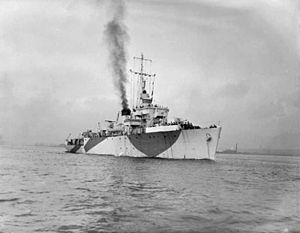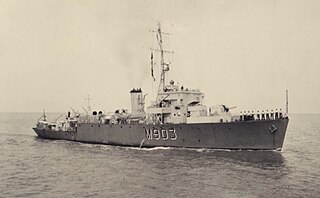
The Algerine-class minesweeper was a large group of minesweepers built for the Royal Navy (RN) and the Royal Canadian Navy (RCN) during the Second World War. 110 ships of the class were launched between 1942 and 1944.

HMS Rifleman was a turbine-powered Algerine-class minesweeper of the Royal Navy. She was launched in 1943 and saw active service during World War II, both in the European and Far East theatres. After the war she served in the Mediterranean and was used as an accommodation ship in Barrow before being sold for breaking in 1972.

HMS Loyalty was a turbine-powered Algerine-class minesweeper of the Royal Navy, formerly HMS Rattler. She served during the Second World War. Commissioned in 1943, Loyalty saw action off the coast of Normandy during the Allied assault there in 1944. While performing duties off the coast, the ship was torpedoed by a German submarine and sank.

HMS Squirrel was a turbine-powered Algerine-class minesweeper built for the Royal Navy during the Second World War. She was scuttled after striking a mine in 1945.
Operation Livery was a series of naval air strikes on northern Japanese occupied Malaya and air cover missions for minesweeping operations by the British in July 1945 during World War II. It was carried out by the 4th and 7th Minesweeping Flotillas, taking place off Phuket Island, Thailand. It was the last action of the Eastern Fleet during the war.

HMS Algerine was the lead ship of her namesake class of minesweepers built for the Royal Navy during World War II, the Algerine-class minesweepers. Initially assigned to the North Sea, she was transferred to lead the 12th Minesweeping Flotilla. The Flotilla were posted to the Mediterranean to assist with Operation Torch. In 1942, after a successful mine clearing operation off Bougie, she was torpedoed by the Italian submarine Ascianghi, causing Algerine to sink, leaving only eight survivors.
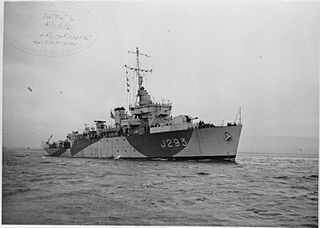
HMCyS Parakrama, was a turbine-powered Algerine-class minesweeper of the Royal Ceylon Navy, originally built as HMS Pickle (J293) for the Royal Navy during World War II, and transferred to Ceylon by the United Kingdom in 1958. She was scrapped in 1964.
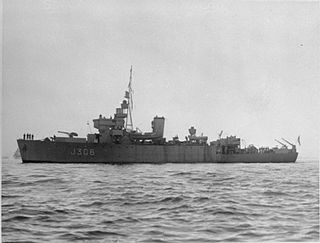
HMS Fly (J306) was a reciprocating engine-powered Algerine-class minesweeper during the Second World War. She survived the war and was sold to Iran in 1949 as IISPalang.

HMS Hare (J389) was a turbine engine-powered Algerine-class minesweeper during the Second World War. She survived the war and was sold to Nigeria in 1958 as HMNS Nigeria.

HMS Rosario (J219) was a turbine engine-powered Algerine-class minesweeper during the Second World War. She survived the war and was sold to Belgium in 1953 as De Moor (M905).

HMS Spanker (J226) was a turbine engine-powered Algerine-class minesweeper during the Second World War. She survived the war and was sold to Belgium in 1953 as De Brouwer (M904).
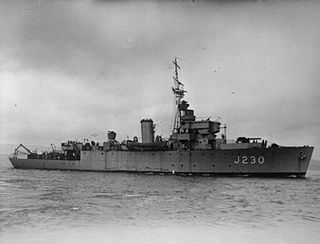
HMS Cadmus (J230) was a turbine engine-powered Algerine-class minesweeper during the Second World War. Launched in 1942 the ship survived the war and was sold to Belgium in 1950 as Georges Lecointe (M901).

HMS Brave (J305) was a turbine engine-powered Algerine-class minesweeper during the Second World War.

HMS Chameleon (J387) was a turbine engine-powered Algerine-class minesweeper during the Second World War.

HMS Cheerful (J388) was a turbine engine-powered Algerine-class minesweeper during the Second World War.

HMS Circe (J214) was a turbine engine-powered Algerine-class minesweeper during the Second World War.
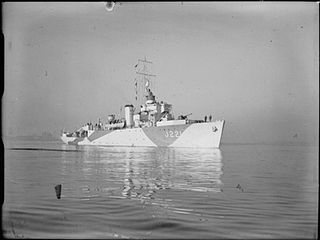
HMS Onyx (J221) was a turbine engine-powered Algerine-class minesweeper during the Second World War.
